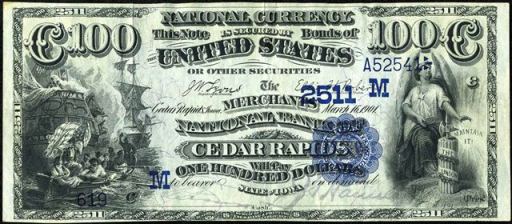The Union National Bank Of The City Of New York
The Union National Bank Of The City Of New York in New York printed $1,048,500 dollars worth of national currency. Over $1,000,000 face value is a lot of money. However, some types and denominations of currency from this bank could still be rare. This national bank opened in 1865 and stopped printing money in 1885, which equals a 21 year printing period. That is a fairly normal lifespan for a national bank. During its life, The Union National Bank Of The City Of New York issued 11 different types and denominations of national currency. We have examples of the types listed below. Your bank note should look similar. Just the bank name will be different. For the record, The Union National Bank Of The City Of New York was located in New York County. It was assigned charter number 1278.
We buy all national currency. Please call or email us for a quote. Sales@AntiqueMoney.com
The Union National Bank Of The City Of New York in New York printed 11,000 sheets of $1 original series national bank notes. These notes were only printed until 1875. For a national bank to print more than 10,000 means that they were doing a lot of business. Your exact note is likely still rare. The value will be more condition based than rarity based though. One of the most interesting things about early first charter one dollar national bank notes is all of the different slight variations you can find. Some notes have a red charter number, others do not. Some have red serial numbers and some have blue serial numbers. Some are printed on white paper and others are printed on paper with a slight blue tint. You can really find lots of different ways to collect these. Generally speaking, prices for “first charter aces” are down from their highs. So there are some bargains in this arena of collecting.
Original Series $1 National Bank Note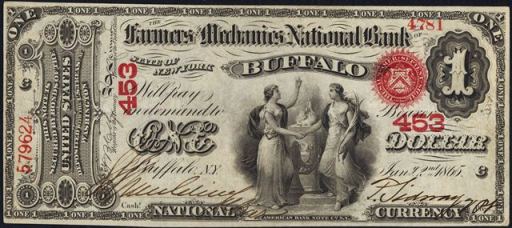
The Union National Bank Of The City Of New York printed 11,000 sheets of $2 original series national bank notes. It is important to know production numbers for original series two dollar bills for informational purposes. All $2 bills printed before 1875 are very rare and highly desirable. Most survivors represent the only known example for that bank. Collectors call these $2 bills lazy deuces. The large two on the face of the bill is pictured horizontally, thus making it look lazy. Don’t be fooled by the silly name though. These can be worth significant amounts of money on many occasions.
Original Series $2 National Bank Note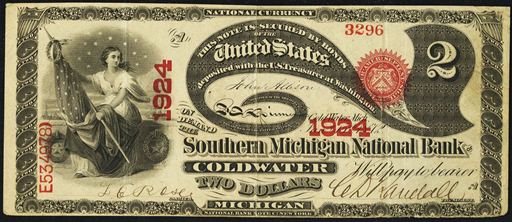
The Union National Bank Of The City Of New York also printed 13,630 sheets of $5 original series national bank notes. These notes were only printed until 1875. For a national bank to print more than 10,000 means that they were doing a lot of business. Your exact note is likely still rare. The value will be more condition based than rarity based though. Each five dollar original series bank note has a spiked red seal. That is pretty much the only design difference between it and later issues. These are really beautiful notes. One neat thing about these is that the back of each note has a vignette of the corresponding state seal. Some of the state seals are very imaginative. Collecting by state seal was very popular early on in the hobby. Today most collectors are more concerned about bank of issue and condition. Serial number one bank notes are also extremely popular.
Original Series $5 National Bank Note
The Union National Bank Of The City Of New York also printed 4,600 sheets of $10 original series national bank notes. It is actually pretty standard for an early national bank to have a sheet output range between 2,500 and 5,000. The exact value of a bill is still going to be based on the number of notes known and the condition of each bank note. These notes were issued during the glory days of the national bank note era. Each $10 bill was pen signed by the president and cashier of the bank. Small towns and large cities both issued these notes. Of course the small town issuers tend to be scarcer today. Prices range from $500 to thousands of dollars (and more if the condition and rarity warrant it). Contact us if you need help valuing your bank note.
Original Series $10 National Bank Note
The Union National Bank Of The City Of New York also printed 4,600 sheets of $20 original series national bank notes. That issue number may or may not sound like a lot of sheets depending on your experience with collectible currency. However, all original series $20 bills are rare. The production amount is irrelevant when it comes to values. These seem like common issues until you want to buy one. These just aren’t readily available from rare banks in very fine or better condition. We definitely feel like these are undervalued in today’s market.
Original Series $20 National Bank Note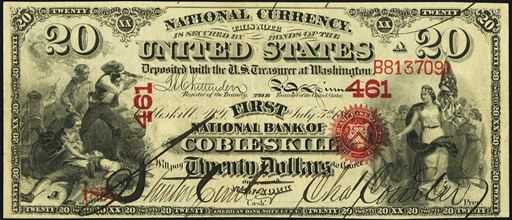
The Union National Bank Of The City Of New York also printed 1,000 sheets of $50 original series national bank notes. The printing number for original series $50 bills is irrelevant. There are only about 35 known to exist from all banks in the country. Despite being extremely rare, condition is still very important. Lots of first charter fifty dollar bills are heavily circulated; there are significant premiums for anything that grades extremely fine or higher.
Original Series $50 National Bank Note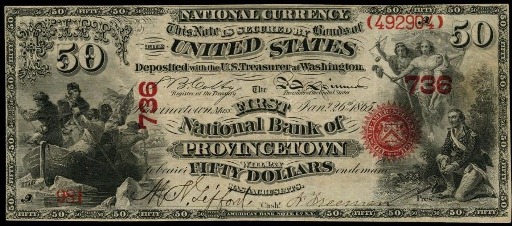
The Union National Bank Of The City Of New York also printed 1,000 sheets of $100 original series national bank notes. The same piece of advice applies here as it does to first charter fifties. These are rare enough to the point that printing numbers don’t matter. The same condition guidelines apply to original series $100 bank notes. These traded hands frequently and are often found in “well-used” states today. As with other bank notes, there can be huge price gaps between different grade points.
Original Series $100 National Bank Note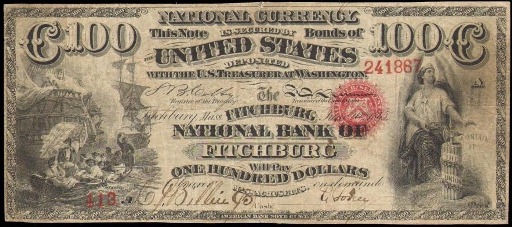
The Union National Bank Of The City Of New York also printed 518 sheets of $10 1882 blue seal national bank notes. 1882 blue seals are traditionally not the most popular national bank notes. However, when we are talking about such a low print number, these become much more desirable. All of these notes say series of 1882 but they were actually printed between 1908 and 1921. So they aren’t quite as old as the dates might suggest. There is also a date on these notes that is between 1888 and 1901. That date is written in cursive text and it represents when the bank was chartered or re-chartered. Some of the so called 1882 value back notes have a chance to be really rare. Most of the earlier notes that say 1882-1908 on the back are likely going to be relatively common. The designs are exactly the same on the front. Each has a blue seal and charter number.
1882 Blue Seal $10 National Bank Note
The Union National Bank Of The City Of New York also printed 518 sheets of $20 1882 blue seal national bank notes. That is the same number of sheets as the ten dollar denomination. You don’t have to multiply by three to get the exact number of notes issued though. There was only one twenty dollar bill per sheet. As with any national bank note, the exact value is still based on the condition, serial number, and bank of issue.
1882 Blue Seal $20 National Bank Note
The Union National Bank Of The City Of New York also printed 400 sheets of $50 1882 blue seal national bank notes. High denomination 1882 blue seals like this are not frequently encountered, regardless of the number of notes printed. There is a big difference between the two types of 1882 $50 blue seals. The variety that says “1882-1908” on the back is rare, but no where near as rare at the type that says “Fifty Dollars.” The second variety is extremely rare and only about a half dozen are known to exist. The first type should still be worth at least $4,000. The second type is a five figure rarity though.
1882 Blue Seal $50 National Bank Note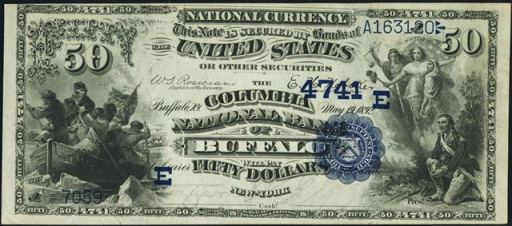
The Union National Bank Of The City Of New York also printed 400 sheets of $100 1882 blue seal national bank notes. The number of sheets printed doesn’t matter too much here. All 1882 $100 blue seals are rare. They were issued by a total of 256 total national banks in the country. The rare 1882 value backs were only printed by banks in Dayton, Ohio and New Orleans, Louisiana. The slightly more common date backs are much more plentiful but still rare in the scheme of things.
1882 Blue Seal $100 National Bank Note